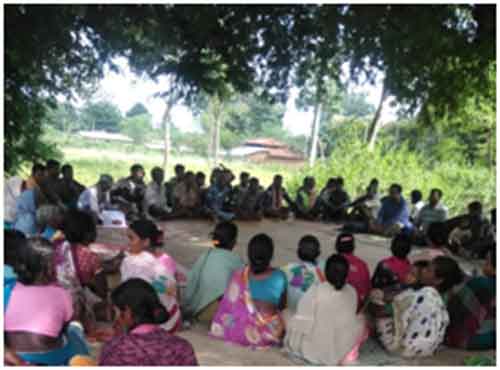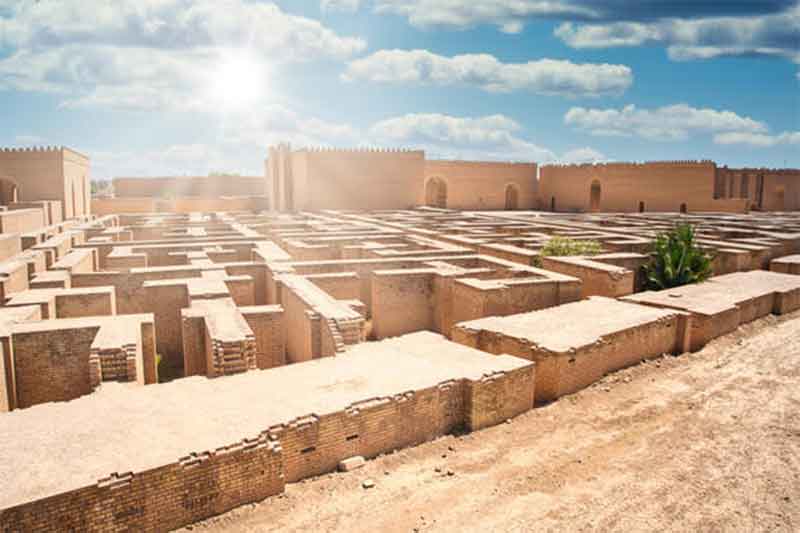Co-Written by Bibhubanta Barad. Parijat Ghosh and Dibyendu Chaudhuri

Introduction
It was a sunny summer morning in 2017. Self Help Group (SHG) members of Jana[1] congregated beneath the tamarind tree, their usual meeting place. Some men also were sitting there and the SHG members were taking loan to purchase inorganic fertilizers and hybrid seeds. They were discussing whether they would go for the indigenous variety of crops that they had been growing in previous years. When enquired they informed that some seed company representatives came and shared with them about the ‘benefits’ of using hybrid seeds. They also recommended following a package of practice (POP) which included using inorganic fertilizers and pesticides. As the costs were high they needed to take loan from the SHG. Some older villagers shared their concern over the increasing trend of using hybrid seeds along with inorganic fertilizers among the younger generation. Pitu Bhagat, a man in his 40s stood beside the tamarind tree and stated with pride “hum log abhi standard khana kha rahe hain, madwa bagera abhi khana nahi padta” (Translation: we are now taking standard food, we don’t need to take finger millet kind of things anymore); but one old person from that group confronted Pitu saying, “Nahi, hum abhi zahar kha rahe hai, ise humara zindegi chhota ho raha hai or taqat bhi ghat gaya” (Translation: No, we are now eating poison and for that our lifespan is reducing with deprived health condition).
Like any other Adivasi villages in Jharkhand, Jana also had a rich traditional agriculture system, a large variety of crops, seed storage systems along with regenerative agriculture practices. With the growing emphasis on modern agriculture, representatives from various seed and pesticide companies, Govt. and civil society organisations (CSOs) started influencing the villagers. The traditional systems started getting replaced by inputs and POPs provided by them fuelling a phenomenon known as deskilling in agriculture (Vandeman, 1995). In most of the cases such adoptions were without knowing the full information and long term effect. With short term gain their mindset started deviating from their time tested knowledge and practices. However, in Jana, it was still a possibility to reverse this changing mindset as some of the villagers, such as the old man, still were not convinced about these changing practices.
In this article the authors describe the journey of Jana villagers towards restoring their faith in their regenerative agricultural practices. We claim that through conscious efforts it is possible to restore the belief by accepting belongingness, collective effort, conservatism and self-governance as a way of life of a cohesive community.
The growing trend
In the past, the agriculture practices in Jana, like many other Indian villages, involved collective ploughing, seed sowing, weeding etc. Private property was a notional demarcation, not a legal document. Due to privatized incentives like subsidies and land ownership, infiltration of modern instruments such as tractor or weeder and increasing focus on individual prosperity people started doing agriculture individually and gradually forgot the collective ethos. Increased population and shifting to nuclear families led to division of land into smaller patches. This led to food insufficiency and lack of support from the larger family when needed. In many cases it forced people to migrate to cities where they got exposed to urban lifestyle and got habituated with that. After returning to the village they wanted to incorporate some of those habits in their life in the village. Also, incentivization through different government schemes/CSOs/Outside agencies attracted the community to follow the processes designed by them and in this process their mindset changed. Social interaction within and outside the village, advertisement, and mass communication of companies/CSOs/institutions brought new ideas and adoption of modern technology (Stone, 2007). These social interactions or networking with each other facilitated people to change their mindset and understanding (Sligo & Massey, 2007). People in Jana started changing their practices in the following ways:
- Using hybrid variety of seeds, machines, inorganic fertilizer, etc. in their farming system
- Installing and using bore-well for Irrigation
- Giving more focus on individual progress rather than community well being
- Shifting from agriculture and depending more on wage earning
- Younger generation migrating to cities for better earning opportunities
Currently the highly nutritious local varieties of paddy are grown by very few. Temba Oraon says: “pahle logon ka naam jitna tha utna dhan ka prakar tha – abhi logon ka naam ke samne dhan ka naam bahut kam hai”(Translation: We had more paddy variety names compared to the number of names of people – now we have very less number of paddy varieties in comparison to names of people).
Human mindset operates/changes due to both external and internal factors (Mills, Gaskell, Ingram, Dwyer, Reed, & Short, 2016). Karl Marx said, “Ensemble of Social Relations can change the Human Essence”, which means people expand their social relation as their thought, and then aspirations change. Green revolution in agriculture and globalized economy changed agriculture and reshaped people’s aspirations and sense of need.
Journey with a reverse gear
It all started with Adaptive Skilling through Action research (ASAR), a joint initiative of Azim Premji University (APU), PRADAN and a group of villagers of Jana are co-researchers in this endeavor. The research aims at adaptive skilling of people in their socio-ecological systems. It evolved around three principles:
- Maintaining balance between individual prosperity and collective wellbeing as agrarian livelihoods are predominantly individual enterprises based on common resources
- Reducing dependency on market for agriculture practices and inputs such as seeds and fertilizers
- Adaption of any new technology through experimentation and analysis by the villagers
ASAR started with a discussion around the idea of ‘Khushaal Zindagi’ (Good life) with all the villagers. People from different age and gender groups shared different aspirations. On one hand, older generation aspired for holding on the collective ethos and traditional practices- older generation said, “Purkho ka gyan bachana hain”/ “Hamara jangal hara bhara to khet bhi hara bhara”/ “mitti ko bachana hai” (Translation: We need to restore the traditional knowledge / Our forest as well as land will be greener / we need to conserve soil). The younger generation, on the other hand, aspired for a life having modern amenities and technologies in place, indifferent to community ethos. They said, “Hametoh bike chahiye, mobile chahiye, pakka ghar chahiye”/ “kheti ke liye borewell hi chahiye, ushi se hi sahi kheti ho payega” (Translation: We want motor bike, mobile, pucca building, bore-well for irrigation for doing proper agriculture).
Following the discussion on ‘Khushaal Zindagi’, in which villagers from almost all households of Jana were present, an exposure to Mendha Lekha[2] was organized. It boosted enthusiasm among the villagers further. After coming back from Mendha they applied for CFR and started the process of making an ethno-medicine register.
An Adhyayan (study) group was formed. Initially there were five members in the Adhyayan group. Adhyayan group members used to facilitate fortnightly meetings of villagers to discuss and plan activities, mostly farm-forest based. In these meetings, apart from them, another around twenty people used to participate. However, these 20 kept on changing; different people were attending different meetings. Gradually the enthusiasm around ‘Khushaal Zindagi’ started dissipating.
Nevertheless, in the meantime, the number of members in the Adhyayan group rose to 10. Some villagers who were not taking interest initially they started showing interest through their participation and leadership in the meetings and activities such as preparation of ethno-medicine register, sanitation well or gathering different varieties of indigenous seeds. They were included in the Adhyayan group.
In September 2019, a whole day meeting was organized involving people from all the households of the village. In that meeting they discussed about protecting soil fertility, maintaining the level of organic matter, encouraging biological activity in soils, providing nutrients through the microbial action, recycling organic matter, managing diseases, pests and weeds through the use of techniques like natural predators, organic manuring, crop rotation, maintaining diversity, growing resistant varieties, water management, etc. They also discussed the usefulness of conducting experiments before accepting any products or technology blindly. All those were done through small video shows, lectures and interactive sessions.
This event had a major impact on the villagers. They came up with a set of objective that they want to achieve in near future; which are as follows:
– Hara bhara khet (evergreen agricultural field)
– Hara bhara jungle (green forest)
– Bharpur pani ka sadhan hona (adequate water availability)
– Sabke saath aage badhna (Collective wellbeing and progress)
– Swasth Rehna (Being healthy)
Towards those objectives they planned many small experiments such as ways of soil fertility or mulching using locally available material. Now, the 10 Adhyayan group members sit with villagers in small affinity groups and discuss the experiments.
Changing Scenario:
The intense engagement in the last two years in ASAR led to many changes in their mindset, changing the dominant trend. Some changes are visible in following areas:
- Reducing use of inorganic fertilizer and increasing use of organic fertilizer: Less number people are using chemical fertilizers. There has been 59% reduction in the number of households applying chemical fertilizers.
- Use of hybrid vs local paddy seeds for cultivation: In the Kharif season of 2019, out of the total 46 households surveyed, only in 3.8 acres (out of 62.8 acres under paddy) hybrid seeds were sown. This clearly shows a reversal of the trend.
- Deep Borewell vs. Sanitary well: It was interesting to observe the way Jana villagers decided sanitary well over bore-well as a sustainable option. A group of people was interested to dig bore-well for irrigation and water supply in the village. But other villagers cited examples of Chennai water scarcity[3] and examples from Maharastra[4], which they saw in one of the video shows. The villagers discussed the necessity of ground water monitoring through open wells by observing its water table, especially in the summer months and discarded installation of bore-wells as through bore wells water is pumped out injudiciously leading to depletion of groundwater. The villagers together opted for sanitary well and water supply through a solar based pumping system. Sanitary wells are similar to open wells but properly constructed, and well protected from possible locations of contamination so as to ensure supply of safe water.
- Mindset for Experimentation: We also have observed a changed attitude towards adopting new methods and technology. A group of farmers have started taking interest in experimenting different methods, keeping data, analyzing the pros-cons and adapting as per their context. For example, they are experimenting with different methods for seed conservation and effect on germination. They are also modifying the prescribed Package of Practice (PoP) based on inputs available in the village and observing the effect.
- Preserve and Rejuvenate bio-diversity and knowledge transfer to the younger generation: Villagers identified ignorance as one of the reasons for the younger generation for not taking interest in protecting forest and the traditional wisdom of the agriculture system. A group of people have prepared Ethno-Medicine book[5] and Biodiversity register[6]. They also have discussed it with the younger generation. Hirasandh, a middle aged farmer from the village, says, “Hum log aapna jungle or watabaran ko bachayenge, dusre ko sikhayenge aur gaon ko behtar banayenge” (Translation: We will rejuvenate our forest and environment, we will teach others and we will make a better village).
- Going back to collective thinking in better informed ways: The village collectives became dysfunctional as people started focusing on the individual prosperity. However, their visit to Mendha Lekha[7] in Maharashtra followed by regular intensive discussion helped them to understand the importance of thinking about the village as a whole in order to ensure sustainable agricultural practices. They have planned to have monthly gram sabha with participation of at least one member from each family. This will act as a platform to discuss issues affecting the village, plan for collective actions, and take decisions based on the ASAR principles. They want to rebuild the cohesive environment that they had earlier through mutual support to one another like collective ploughing, weeding and support in marriage. Village study group is supposed to enrich collective decisions with required information sourced from relevant institutions.
- Another budding thought is to become self-sufficient. They started aspiring that all primary needs of the villagers are met from within the village. For example, if they can calculate the total food requirement of the village they can plan to grow crops to cater to this need with some surplus. Similarly, other services can also be planned within the village.
Conclusion:
Jana was following the dominant trend found in rural India where farmers adopt modern agriculture using hybrid seeds and chemicals. Like others, they also started following agronomic practices prescribed by the companies who sell seeds, pesticides or fertilizers. However, soon they could realise that this shift was becoming detrimental for their land, health and, above all, for their community. Partaking in the action research ASAR, they started deliberating about those in their village gatherings, attending training programs on principles of agronomy and natural cycles, and visiting places where people have been able to resist the mainstream trends. Within a span of two years things started changing. Villagers began choosing indigenous varieties of seeds and using non-chemical management of soil fertility and pests. They also started rebuilding their village forums and reviving the community practices of cooperation and reciprocation, conscious about the need to keep informed about appropriate new technologies and individual freedoms. Thus, this example of Jana shows that in spite of living in a society which thrives for individual prosperity and consumerism, it is possible to start an alternative way of living with collective thinking and action towards a sustainable society.
Reference
Levins, R. A., & W.Cochrane, W. (1996). The Trademill Revisited. Land Econimics.
Mills, J., Gaskell, P., Ingram, J., Dwyer, J., Reed, M., & Short, C. (2016). Engaging farmers in environmental management through a better understanding of behaviour. Agriculture and Human Values, Volume 34, 283–299.
Sligo, F., & Massey, C. (2007). Risk, trust and knowledge networks in farmers’ learning. Journal of Rural Studies, 23(2):170-182.
Stone, G. D. (2007). Agricultural Deskilling and the Spread of Genetically Modified Cotton in Warangal. Current Anthropology, 67-103.
Vandeman, A. M. (1995). Management in a Bottle: Pesticides and the Deskilling of Agriculture. Review of Radical Political Economics, 49-59.
[1] Jana is situated 20 kms away from district headquarter of Gumla, Jhakhand. Almost 90% of the 140 Households in Jana belong to Oraon tribe.
[2] Mendha Lekha is a village in Gadchiroli district of Maharasthra which is the first village in India to secure Community Forest Right. It has got the right of over 1,800 hectares of forest surrounding it.
[3] https://youtu.be/tDRItToDWa4?t=240
[4] https://youtu.be/3zQAXaVcV-c
[5] A group of villagers prepared a register containing their traditional knowledge of indigenous medicines using different parts of plants, insects and animal
[6] A register containing the information, including usage of different parts, about flora in the village and nearby Jungle
[7]https://mr.wikipedia.org/wiki/%E0%A4%AE%E0%
A5%87%E0%A4%82%E0%A4%A2%E0%A4%BE_
(%E0%A4%B2%E0%A5%87%E0%A4%96%E0%A4%BE)
Bibhubanta Barad is working in Professional Assistance for Development Action (PRADAN – a non-profit organization in India) for last 10 years with experiences of engagement with Adivasi community of Madhya Pradesh, Odisha and Jharkhand, to help them in strengthening their life and livelihoods. He specializes in community mobilization, stake-holders linkage building, planning-monitoring and agriculture. By education he has done MBA. (Contact: bibhubantabarad@pradan.net)
Parijat Ghosh, an electrical engineer turned development practitioner, has more than 15 years of experience of working with marginalised people in Central Indian Plateau. Her work involved mobilising women in small groups to help them take up activities such as savings and credit, reeling and spinning of tasar yarn, agriculture, etc. She is currently based at New Delhi and working as Team Coordinator, Research and Advocacy in an Indian Non-Profit organisation called Professional Assistance for Development Action (PRADAN), She also has worked with the human resource development unit of PRADAN, where she provided leadership in designing and conducting the early training. Her interest areas include organisation development, sustainable intensification and gender. She is also part of the editorial board of Journal of International Women’s Studies (ISSN: 1539-8706).(Contact: [email protected])
Dibyendu Chaudhuri is currently working in Research & Advocacy unit of Professional Assistance for Development Action (PRADAN), a non-profit organisation in India. A Geologist by education, Dibyendu has spent more than 22 years in mobilising people from indigenous communities in central Indian plateau and helped them in strengthening their livelihoods. He specialises in Human Resource Development, Monitoring-Evaluation-Learning, Integrated Natural Resource Management and Micro-finance. He is also part of the editorial board of Journal of International Women’s Studies (ISSN: 1539-8706). (Contact- [email protected])
A shorter version of the article was published in the Civil Society Magazine
SIGN UP FOR COUNTERCURRENTS DAILY NEWSLETTER















































